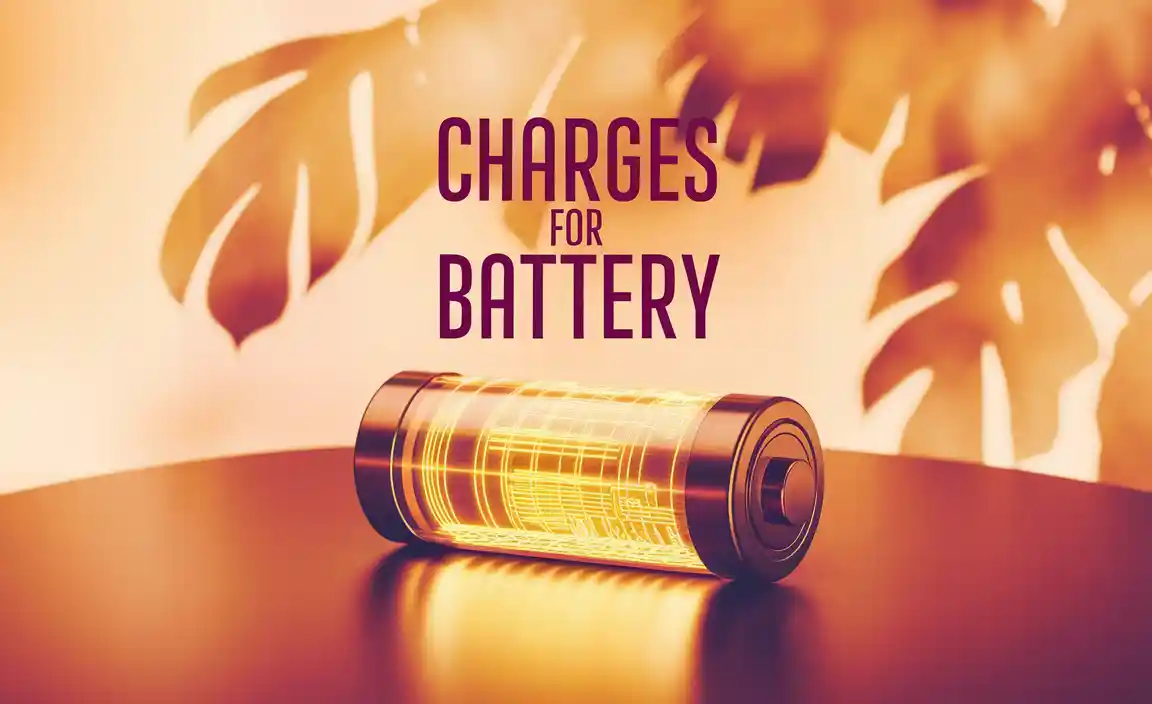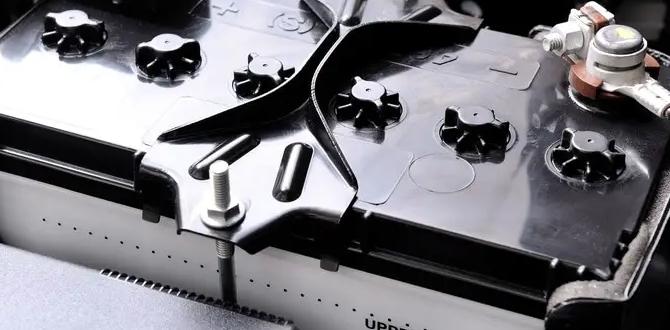Quick Summary:
Finding the right replacement battery for your Pride scooter is crucial for reliable power and smooth mobility. Look for the exact model number specified by Pride, consider sealed lead-acid (SLA) or lithium-ion types, and ensure it matches voltage and amp-hour ratings for proven performance.
Getting stuck because of a dead scooter battery is incredibly frustrating, especially when you rely on your Pride scooter for independence and getting around. It’s like your trusty sidekick suddenly running out of steam. But don’t worry, this problem happens to everyone who uses mobility devices.
The good news is that replacing your Pride scooter battery is usually a straightforward process. You don’t need to be a tech wizard to keep your scooter powered up and ready for adventure. We’re here to guide you through understanding your options and making the best choice for a replacement battery.
Let’s break down what you need to know to get your Pride scooter back to its full, proven power. We’ll cover everything from identifying the right battery to simple installation tips.
Why Battery Power Matters for Your Pride Scooter
Your Pride scooter’s battery is its heart. It’s what gives you the go-power to move freely and enjoy your day. When that battery starts to fade, so does your ability to go where you want, when you want. This can really put a damper on your daily life.
A good battery means more than just getting from point A to point B. It means:
- Consistent Speed: No more slowing down unexpectedly on hills or flat stretches.
- Longer Range: More freedom to travel further without worrying about running out of juice.
- Reliability: Peace of mind knowing your scooter will start and perform as it should, every time.
- Safety: Adequate power ensures your scooter operates safely, especially on inclines or when you need to move quickly.
Think of your scooter battery like the fuel in a car. When it’s fresh and full, the engine runs smoothly. When it’s old or low, the performance suffers. That’s why choosing the right replacement battery for your Pride scooter is so important.
Understanding Pride Scooter Battery Types
Pride Mobility uses a few different types of batteries in their scooters, and knowing which one you have is the first step to finding a replacement. The most common types you’ll find are Sealed Lead-Acid (SLA) batteries, which are the standard for many mobility devices, and increasingly, Lithium-ion batteries are becoming an option offering lighter weight and longer life.
Sealed Lead-Acid (SLA) Batteries
SLA batteries are what you’ll find in the majority of Pride scooters. They are a reliable and cost-effective choice. These batteries are “sealed,” meaning they don’t require maintenance like older types of lead-acid batteries that needed water added. They are also spill-proof, which is a major plus for safety.
Here’s what makes SLA batteries popular:
- Affordable: Generally less expensive upfront compared to other battery technologies.
- Robust: They are known for being durable and producing a consistent power output.
- Widely Available: Easy to find replacements for most scooter models.
- Proven Technology: A long track record of successful use in mobility scooters.
However, SLA batteries are heavier, and their lifespan is typically shorter than newer technologies. They also require a specific charging routine to get the most out of them.
Lithium-ion (Li-ion) Batteries
Lithium-ion batteries are a newer, more advanced option. They are becoming more common in high-end scooters or as an upgrade. Li-ion batteries are significantly lighter than SLA batteries, which can make your scooter easier to handle, transport, and charge.
The benefits of Li-ion batteries include:
- Lighter Weight: A big advantage for portability and ease of handling.
- Longer Lifespan: They can typically handle more charge cycles, meaning they last longer over time.
- Faster Charging: Often charge quicker than SLA batteries.
- Higher Energy Density: More power can be packed into a smaller, lighter battery.
The main drawback of Li-ion batteries is their higher upfront cost. While they might save you money in the long run due to their lifespan, the initial investment is an important factor.
How to Find the Right Replacement Battery for Your Pride Scooter
Choosing the correct battery is the most critical step to ensure your Pride scooter runs perfectly. Using the wrong battery can lead to poor performance, damage to your scooter, or even safety hazards. Let’s make sure you get it right.
Step 1: Identify Your Pride Scooter Model
This is the most important piece of information. Every Pride scooter model, like the Go-Go Elite Traveller, Revo 2.0, or Zero Turn, is designed to work with specific battery sizes and types. You can usually find the model name on the scooter itself, often on a label on the frame or tiller (the part you steer).
Look for labels or plates that might say:
- Model Name (e.g., “Pride Go-Go Ultra X”)
- Serial Number
- Manufacturer Information
If you can’t find it on the scooter, check your owner’s manual or any documentation you received when you purchased the scooter. If all else fails, contact Pride Mobility customer support with your scooter’s serial number, and they can help you identify the exact model.
Step 2: Check Your Current Battery
Your best bet for finding the right replacement battery is to look at the specifications of your existing battery. Most batteries have labels with crucial information. You’re looking for:
- Battery Type: Is it SLA (often indicated by “AGM” or “VRLA”) or Li-ion?
- Voltage (V): This usually comes in 12V or 24V for scooters.
- Amp-Hour (Ah) Rating: This tells you how much energy capacity the battery has. A higher Ah rating means longer run time. Common ratings are 18Ah, 22Ah, 30Ah, 35Ah, 50Ah, etc.
- Dimensions: The physical size of the battery (length, width, height) is essential to ensure it fits in the battery compartment.
- Terminal Type: How the wires connect (e.g., spade connectors, bolt-on terminals).
Safety Tip: When examining your current battery, ensure your scooter is powered OFF and the brakes are engaged. If you’re unsure about removing the battery yourself, it’s best to leave it in place and note the information. You might need to consult your scooter’s manual for removal instructions.
Step 3: Match the Specifications
Once you have the essential details from your current battery or scooter manual, you need to find a replacement that matches. For example, if your scooter uses two 12V 22Ah SLA batteries, you’ll want to replace them with two more 12V 22Ah SLA batteries.
Important Considerations:
- Voltage MUST Match: Using a battery with the wrong voltage can damage your scooter’s electronics.
- Amp-Hour (Ah) Can Be Higher: You can generally use a battery with a higher Ah rating than your original, as long as it fits physically. This will give you longer run time. Don’t go lower, as it will reduce your range.
- Physical Size is Critical: The battery must fit in the designated space. Measure your current battery carefully if the labels are unreadable.
- Chemistry Type: It’s usually best to stick with the same battery chemistry (SLA or Li-ion) unless your manual specifically states an alternative is compatible.
Step 4: Choose a Reputable Supplier
Where you buy your replacement battery matters. Look for suppliers that specialize in mobility scooter batteries and have good reviews. Reputable sources often:
- Clearly list battery specifications.
- Offer warranties on their products.
- Provide excellent customer support to help you choose the right battery.
- Partner with known battery manufacturers.
Many authorized Pride Mobility dealers also sell replacement batteries. You can also find specialized online battery retailers. For important information on battery safety and testing, the U.S. Department of Energy offers resources on battery technologies and safety standards.
Key Battery Specifications Explained
Let’s clarify some of the terms you’ll see when shopping for your replacement battery, making it easier to choose. This knowledge is power, literally!
Voltage (V)
Voltage is like the “pressure” of the electrical flow from the battery. Most Pride scooters use a 24-volt electrical system. This means they typically use two 12-volt batteries connected in series to achieve the 24 volts. It’s crucial that your replacement batteries’ combined voltage matches what your scooter requires. A mismatch can cause serious damage.
Amp-Hour (Ah)
Amp-hours measure the battery’s capacity – how much energy it can store and deliver over time. A higher Ah rating means the battery can power your scooter for longer on a single charge. For example, a 35Ah battery will typically provide more range than an 18Ah battery, assuming all other factors are equal.
When choosing a replacement battery, you can usually opt for a higher Ah rating than your original, provided the physical size and weight are manageable and it fits your scooter’s battery compartment. This is a great way to increase your travel range.
Battery Size and Physical Fit
Scooter battery compartments are designed to fit specific dimensions. If a battery is too large, it simply won’t fit. If it’s too small, it might not be secure, or it could move around. Always confirm the dimensions (Length x Width x Height) of the replacement battery match or are compatible with the space available in your Pride scooter.
Battery Terminal Type
The terminals are where the battery connects to the scooter’s wiring. Common types include:
- F1/F2 Terminals: These are small spade-like connectors commonly found on smaller SLA batteries.
- Threaded Studs: Larger batteries might use bolts that screw into threaded studs.
Ensure your new battery has the same terminal type and orientation as your old one, or that you have the correct cables and connectors to adapt it.
Comparing Battery Options: SLA vs. Li-ion for Pride Scooters
To help you visualize the differences and make an informed decision, here’s a comparison table highlighting the key aspects of Sealed Lead-Acid (SLA) and Lithium-ion (Li-ion) batteries for your Pride scooter.
| Feature | Sealed Lead-Acid (SLA) | Lithium-ion (Li-ion) |
|---|---|---|
| Cost (Upfront) | Lower | Higher |
| Weight | Heavier | Significantly Lighter |
| Lifespan (Cycles) | Moderate (e.g., 300-500 cycles) | Longer (e.g., 1000+ cycles) |
| Energy Density | Lower | Higher |
| Maintenance | Virtually None (Sealed) | None |
| Charging Time | Typically longer | Often faster |
| Performance Consistency | Can degrade as charge depletes | Maintains voltage better throughout charge |
| Common Usage in Pride Scooters | Standard | Increasingly an option/upgrade |
Pros and Cons at a Glance
Sealed Lead-Acid (SLA) Batteries:
- Pros: Lower initial cost, robust and dependable power, widely available.
- Cons: Heavier, shorter lifespan than Li-ion, can require more frequent charging cycles over time.
Lithium-ion (Li-ion) Batteries:
- Pros: Much lighter weight, longer lifespan, faster charging, consistent power output.
- Cons: Higher initial investment, may require a different charger (check with manufacturer).
For most users, especially those looking for a direct, cost-effective replacement, SLA batteries are a perfectly good choice. If you’re looking for an upgrade in terms of weight savings and longevity, and the budget allows, Li-ion can be a superior option.
Replacing Your Pride Scooter Battery: A Step-by-Step Guide
Replacing your scooter battery can seem daunting, but it’s designed to be manageable for most users. Always prioritize safety. If you feel uncomfortable at any point, contact a professional or a qualified technician.
Tools You Might Need:
- New replacement battery (correct specifications!)
- Wrench or socket set (to loosen battery tie-downs or terminal bolts, usually 10mm or 13mm)
- Gloves (for protection against dirt and potential battery acid, though SLA batteries are sealed)
- Safety glasses
- Screwdriver set (if accessing battery compartment requires removing panels)
- Wire brush (to clean terminals if corroded)
- Plastic bag or thick cloth (to keep old battery from shorting out if terminals touch metal)
Safety First!
Before starting, ensure your scooter is turned off and has its parking brake engaged. Unplug the charger if it’s connected. Work in a well-lit, well-ventilated area. Lead-acid batteries contain sulfuric acid, and while sealed, they can still vent gases. Avoid sparks or open flames near batteries.
Step-by-Step Replacement Process:
- Access the Battery Compartment: Many Pride scooters have batteries located under the seat or in a compartment at the base. You might need to lift the seat or remove a plastic cover. Consult your owner’s manual for specific instructions for your model.
-
Remove the Old Battery:
- Note the position of the wires. Take a picture if needed.
- Carefully disconnect the wires from the battery terminals. Usually, you’ll disconnect the black (negative, “-“) wire first, then the red (positive, “+”). Use a wrench to loosen any nuts or bolts holding the wires.
- Unfasten any battery tie-downs or brackets holding the battery in place.
- Gently lift the old battery out. Batteries can be surprisingly heavy, so use proper lifting techniques or get assistance if needed.
Important: If you are replacing the battery with another SLA type, and you need to transport it, place the old battery on a piece of cardboard or in a plastic bag to prevent its terminals from accidentally touching any metal surfaces and causing a short circuit.
- Clean Battery Terminals and Compartment: Inspect the battery compartment and the scooter’s wiring terminals. If there’s any corrosion (a white or bluish powder), gently clean it off with a wire brush. Clean terminals ensure a good connection.
-
Install the New Battery:
- Place the new battery into the compartment, ensuring it is oriented correctly so the terminals align with the wires.
- Secure the new battery with the tie-downs or brackets. Make sure it’s snug and won’t move.
-
Connect the Wires:
- Reconnect the wires to the battery terminals. Generally, connect the red (positive, “+”) wire first, then the black (negative, “-“). Tighten any nuts or bolts securely but don’t overtighten.
- Close Up: Replace any covers you removed and lower the seat. Make sure all connections are secure and nothing is left loose.
- Test the Scooter: Turn on your scooter and test its functions – forward and reverse motion, steering, and any accessories. Make sure it operates smoothly.
- Charge the New Battery: Connect your scooter’s charger to the new battery and charge it fully according to the charger’s and battery manufacturer’s recommendations. For new SLA batteries, a full initial charge is always recommended.
Proper disposal of old batteries is essential. Most battery retailers and county hazardous waste collection sites accept old lead-acid batteries for recycling. Never throw




